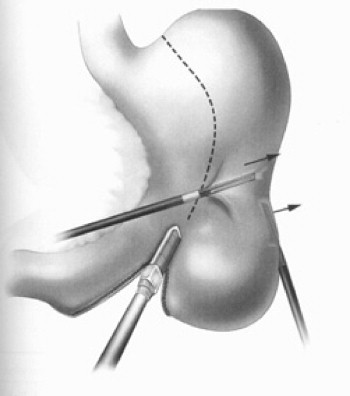The size of your new stomach
 As some may know, I have been trying for WLS since August of 2005. Finally my time came and I was sleeved. I was a very active member on ObesityHelp until I found this site. Enjoy the info and videos...
As some may know, I have been trying for WLS since August of 2005. Finally my time came and I was sleeved. I was a very active member on ObesityHelp until I found this site. Enjoy the info and videos...
The word bougie means "candle" in French. "F or FR/Fr" following a bougie size=French
Its just a guide that the surgeon uses to butt the stapler up against, when forming your VSG. The closer s/he gets to the guide the 'tighter' /truer to guide the sleeve is. During surgery the bougie is inserted into your mouth down your throat, towards the end of yer stomach where it meets the pylorus via an esophageal dilator. After the new stomach is formed, the bougie/guide is removed out of your mouth, possibly why some VSGrs complain of a sore throat post op.
Some surgeons will use an endoscope or other "guide" to size ones new stomach. I read an OH post of a VSGr who's surgeon explained an endoscope is the same size as a 32F bougie...Im not sure.
Bougie size determination is between YOU and YOUR surgeon. Discuss size, rationale for size chosen, type bougie and technique used when sizing your new stomach........ PRE-OP!!
Some surgeons may "oversew" the staple line giving one a 'tighter' than bougie sized sleeve.
In order for an "oversewn" staple line to affect stomach size it MUST be running or continuous oversewn suture line across majority of staple line not intermittent oversewn nor merely at intersected "junctures" where the surgeon has reloaded the staple gun as majority of "oversewn" techniques (to prevent leaks) are done today. Make sure your surgeon explains what his/her "oversewn" technique is. Do not assume because a surgeon "oversews" you have a tighter than bougie sized sleeve.
A bougie is 1/3 mm PER french. i.e to calculate ~ inches 40F bougie 1/3 x 40 = 13.33mm convert to inches = ~.52 inches or ~1/2 inch in diameter.
Below are diameters of bougie/ "guides" in inches
32F = .40"
34F = .425"
36F = .45"
38F = .476"
40F = .5"
46F = .576"
60F = .75"
Video 1
This VSG surgery video shows a 'red' 34F bougie, one technique in sizing stomach, exised stomach, testing for leaks etc
.http://www.orlive.co...eight-loss-surg ery-gastric-sleeve
Red bougies are older mercury filled ones. FDA is tryin to ban em because of disposal issues (mercury).
More surgeons will use SINGLE USE disposable sized bougies
Video 2
In this surgical video Dr. Alvarez shows a disposable 32F bougie and use/technique
~9-2012
In another Forum, this member's bougie pix is from hospital she works at 1st: 36F, 2nd: 38F on left, 32F on right


General/ crude comparison chart created by another Forum member

Standard sized bougies in the US and Mexico are 32F. 32F is the smallest guide a bariatric surgeon in the US may safely use in forming your sleeve. Your surgeon may prefer any size bougie from 32-50F, based on YOU, your height, weight, or perhaps the need for a malabsorptive procedure in the future, inc. 1st step of 2 part DS. Discuss what to expect, rationale for size chosen with your surgeon if this is a concern.
LapSF/Dr. Criangle on their routine use of 32F bougies in VSG "Optimal weight loss may require the smallest possible pouch, which may yield the highest leak rate" .
Some surgeons will welcome discussion and your input on bougie sizes. After reading a published journal on the higher incidence of VSG surgically induced GERD (acid reflux/heartburn) in use of 28-32F bougies, it may be wise to request a higher bougie size. However, like all surgeries, we will need years of data to support whether or not this claim is actually true.
The History of using Bougies
In 2000 the use of 50-60F bougies were standard for VSG when it became a stand alone WLS, as they were the standard sizes of DS bougies, which VSG was modeled after. As the years went by, bariatric surgeons thought..smaller bougie, better restriction, less regain. So in ~2005 an adopted 32F bougie became the VSG standard. Rarely, if ever are 28-30F or 50F and over bougies used in the US for VSG as stand alone anymore. Many many VSGrs do EXTREMELY well with 40F-48F bougies as the guide to sizing their new stomach, losing all the weight they need to.
In 2008 study (small poll 135 pts) on Bougie Sizes in VSG seems to indicate at 6 mos and 12 mos post VSG .... 40F and 60F bougies with no significant difference in EWL (eventual weight loss) 2008 Bougie Size Comparison
In 2009 study (a large poll) on Bougie Sizes in VSG seems to indicate at 5 years post VSG ... 32F and 44F bougies show exactly the same EWL (eventual weight loss) 2009 Bougie Size Comparison
In 2012/13 study (a very large poll) on Bougie Sizes in VSG seems to indicate at 3 years post VSG, a LESS than 40F bougie and GREATER than 40F bougie show no difference whatsoever in EWL (excess weight loss) 2012/13 Bougie Size Comparisons
VOLUME/GASTRIC CAPACITY in VSG:
PRE VSG: Average stomach holds 32-48 oz or 4 to 6 cups per meal
POST VSG (~6-8 months out FOR LIFE) ..new stomach holds 8-12 ozs or 1 to 1.5 cups per meal
(depending on weight/density of foods you eat! can be much less or much more)
The length of an adult stomach is 10-12 inches. DNA affects the length of our stomachs, as well as variations in shape. Tall people, for instance are known to have longer stomachs..so makes sense they have a bit more capacity, short people have shorter stomachs therefore less capacity.... so volume/capacity can be influenced by the length and physical anatomical variations of an individual's stomach.
Dr. Alvarez explains in this You Tube video about length of an individual's VSG stomach and how it relates
to volume.
This limited 2009 study is interesting in looking at gastric capacity in VSG,
just 3 days post op (120 ml=~1/2 cup) compared to 2 years post VSG (250 ml=~1 cup)
http://www.ncbi.nlm.nih.gov/pubmed/19533260
At the end (8:28 mark) of this LapSF VSG surgical video shows 1 DAY old (pod) sleeve Xray and a sleeve Xray at 4 years out. It is not clear to me if same pt. or solely to impress the new "normal" sleeve size. Note the "new normal" 32F tightly formed sleeve has dilated/stretched naturally to perhaps triple in size...The video also shows one technique of sizing the sleeve, as well as reinforcement of the staple line (to prevent leaks)
This VSG video shows the speed with which LIQUIDS/FLUIDS empty from the sleeve. In normal stomachs fluid empty rate is 5 minutes or less due to space creating a reservoir for large volumes of fluids. In VSG stomachs: fluid empty rate looks MUCH faster than that... youdecide!
The COTTAGE CHEESE TEST /CCT (link following) may be helpful to VSGrs that are curious about their new stomachs capacity. It was developed for RNY but an effective tool in VSG as well! I'd suggest waiting until you are on a regular diet before checking. When doing this test PLEASE eat to sensation of satiety - no longer hungry, and absolutely not full.
A simpler method, following the basic guidelines and time frame in the link provided... is to place 1 level cup (8oz) of small curd cottage cheese in a bowl and eat from that. Using a measured tablespoon to eat any remaining cottage cheese from the original container. Add or subtract any cottage cheese eaten or not finished using the measured tablespoon. 2 TBS=1oz. Total...the amount consumed = your sleeve's capacity.
http://www.bsciresourcecenter.com/proddetail.php?prod=A4
STRETCHING in VSG:
YOU CANNOT STRETCH/DILATE out your sleeve to anything remotely close to its original size.
From LapSF/Dr. Criangle: The removed section of the stomach is actually the portion that stretches the most. The long vertical tube shaped stomach that remains is the portion least likely to expand over time and it creates significant resistance to volumes of food.
The fundus (inc. majority of stomachs 'body' up to pyloric canal) of the stomach is ALL but removed with VSG.
The fundus is the upper most part of the stomach's greater curvature. The fundus is:
1) the stomach's stretchy/expandable tissue, capable of expanding 2-3xs its resting 'unfilled' size
2) the pre-op 'mass quantities' of food, waiting to be digested, storage section
3) where 70% of the body's grehlin a "hunger hormone" is produced.
Stretching, due to overeating is most common in RNY because more of the stretchy fundus part of the stomach is retained to make the 'pouch', and is usually NOT covered by insurance to correct. Re-sleeving or a need for a malabsorptive surgery post VSG may or may NOT be covered by your insurance plan.
Anecdotally, Ive read from select OH VSG members, or according to a/their particular surgeon..overeating will cause your sleeve to stretch out. Ive read/found no scientific data, published or otherwise, to date that says this is a TRUE statement.
Since food stays in our stomach less than ~ 3 hours after a meal..common sense tells me food doesn't stay in our stomachs long enough to create 'stretching'. Food once ingested, immediately begins to be churned into a liquidy sludge called chyme through peristalsis in the stomach. This liquidy sludge must be small enough to pass through our very small pyloric valve and into the small intestine for further digestion /breakdown and absorption of 'micronutritents' ...so there cannot be enough pressure for long sustained periods of time in our stomachs to cause it to stretch.
Post op VSG ... depending upon the amount of swelling/inflammation you have..even a little 'thick/er' dense liquids or pureed foods/mushies may or may not feel restrictive, as you pass through the progression of texture dietary phases ( to promote healing) and onto your regular diet ~2mos post op. ... swelling/inflammation has naturally reduced. Density of meals becomes a key player in restriction. By 1 year out you'll find you can eat more than you could at 2 days post op, at 2 weeks post op, 2 months post op, and 6 months post op. Your sleeve has naturally and fully matured.
Depending on the food..you can eat more or less than the 8-12 oz capacity of a fully matured sleeve.......at any particular meal.
Toleration of a food, does NOT make it a good choice!
"just because I CAN...doesn't mean I DO"
---------------------------------------------------------------------------
The bougie size controversy/wars are ridiculous imo.. 'get a smaller one, you can stretch it out, you're not going to have any restriction, that bigger one is all wrong, you'll re-gain easily years out, my surgeon made mine smaller and I got to goal in 6 months'
...all nonsense DO NOT PAY EM NO MIND!! This is YOUR story! YOUR journey!
ALWAYS REMEMBER THIS TRUTH:
YOUR WEIGHT HAS NOTHING TO DO WITH THE SIZE OF YOUR STOMACH, altered or not!
Most important is the quantity and quality of the food choices you ingest post-op













7 Comments
Recommended Comments
Create an account or sign in to comment
You need to be a member in order to leave a comment
Create an account
Sign up for a new account in our community. It's easy!
Register a new accountSign in
Already have an account? Sign in here.
Sign In Now